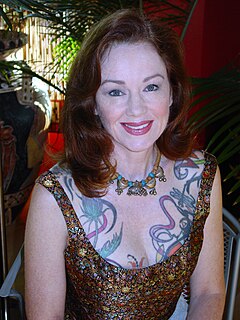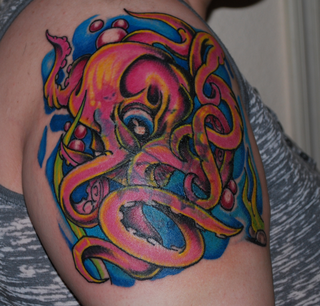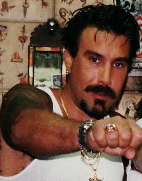
A tattoo is a form of body modification made by inserting tattoo ink, dyes, and/or pigments, either indelible or temporary, into the dermis layer of the skin to form a design. Tattoo artists create these designs using several tattooing processes and techniques, including hand-tapped traditional tattoos and modern tattoo machines. The history of tattooing goes back to Neolithic times, practiced across the globe by many cultures, and the symbolism and impact of tattoos varies in different places and cultures.
Irezumi is the Japanese word for tattoo, and is used in English to refer to a distinctive style of Japanese tattooing, though it is also used as a blanket term to describe a number of tattoo styles originating in Japan, including tattooing traditions from both the Ainu people and the Ryukyuan Kingdom.

Norman Keith Collins, known popularly as Sailor Jerry, was a prominent American tattoo artist in Hawaii who was well known for his sailor tattoos.

A tattoo flash is a design printed or drawn on paper or cardboard, displayed on the walls of tattoo parlors and in binders to give walk-in customers ideas for tattoos. Traditional tattoo flash was designed for rapid tattooing and used in "street shops" — tattoo shops that handle a large volume of standardized tattoos for walk-in customers.

Tattooing has been practiced across the globe since at least Neolithic times, as evidenced by mummified preserved skin, ancient art and the archaeological record. Both ancient art and archaeological finds of possible tattoo tools suggest tattooing was practiced by the Upper Paleolithic period in Europe. However, direct evidence for tattooing on mummified human skin extends only to the 4th millennium BC. The oldest discovery of tattooed human skin to date is found on the body of Ötzi the Iceman, dating to between 3370 and 3100 BC. Other tattooed mummies have been recovered from at least 49 archaeological sites, including locations in Greenland, Alaska, Siberia, Mongolia, western China, Egypt, Sudan, the Philippines and the Andes. These include Amunet, Priestess of the Goddess Hathor from ancient Egypt, multiple mummies from Siberia including the Pazyryk culture of Russia and from several cultures throughout Pre-Columbian South America.

Don Ed Hardy is an American tattoo artist known for his tattoos, strong influence on the development of modern tattoo styles, and his eponymous apparel and accessories brand.

Alpana or alpona is a South Asian folk art style, traditionally practiced by women, and consisting of colored motifs, patterns, and symbols that are painted on floors and walls with paints made from rice flour, on religious occasions. It is common to the Bengal region in India, and in Bangladesh. Amongst Hindu families, alpanas may contain religious motifs with symbolic designs that relate to religious austerity, festivals, and specific deities. Amongst Santal tribal communities, alpanas often contain geometric or symbolic patterns drawn from nature. Although traditionally the domain of rural women, Alpana motifs have been very influential in modern Indian art, and are incorporated into the works of artists such as Jamini Roy, Abanindranath Tagore, Devi Prasad, and in the early illustrations of film-maker Satyajit Ray. In contemporary Bengal, alpanas are created as part of religious festivals such as the Durga puja, in public and private spaces.

Corey Miller is an American tattoo artist and television personality. He began tattooing at the age of 15. He is the owner of a tattoo shop in Upland, California called Six Feet Under. He was one of the core tattoo artists on the reality television show LA Ink.

Sicanje or bocanje is a Serbo-Croatian name for a widespread custom mostly among Roman Catholic Croat women and girls of the central regions of Bosnia and Herzegovina, as well as the Dalmatia region of Croatia. The phenomenon predates the Slavic migration to the Balkans, and consequently Christianity itself, but it was possible to trace its appearance until the middle of the 20th century.

Mary Jane Haake born 1951) is an American tattoo artist and authority on medical tattooing and permanent makeup. She was instrumental in bringing topical anesthetics to the tattooing and body modification industries.
Lift Trucks Project is a project space and artist studio located in Croton Falls, New York. It features up to four long-term exhibitions per year with notable pieces by FA-Q, Christo, Ottmar Hoerl, Ed Roth, A. R. Penck, Sailor Jerry, and others. In addition, Lift Trucks features a permanent "Arts and Industry" exhibit with industrial artifacts and folk art items on exhibit. The name Lift Trucks is derived from the former occupants a forklift repair, sales and service business that occupied the building for over 75 years.

Sailor tattoos are traditions of tattooing among sailors, including images with symbolic meanings. These practices date back to at least the 16th century among European sailors, and since colonial times among American sailors. People participating in these traditions have included military service members in national navies, seafarers in whaling and fishing fleets, and civilian mariners on merchant ships and research vessels. Sailor tattoos have served as protective talismans in sailors' superstitions, records of important experiences, markers of identity, and means of self-expression. Common symbols include swallows, nautical stars, and anchors.

Ben Corday was an American tattoo artist and actor. He is known for being a prolific tattoo flash artist and a progenitor of modern tattooing.

New school is a tattooing style originating as early as the 1970s and influenced by some features of old school tattooing in the United States. The style is often characterized by the use of heavy outlines, vivid colors, and exaggerated depictions of the subject. New school also represents a transition towards openness in the sharing of techniques in tattooing.

Jonathan Dowling Shaw is an American tattoo artist and writer. He founded New York City's oldest tattoo shop, Fun City Tattoo, in 1976, before tattooing was legal in the city.

As in other Polynesian islands, Rapa Nui tattooing had a fundamentally spiritual connotation. In some cases the tattoos were considered a receptor for divine strength or mana. They were manifestations of the Rapa Nui culture. Priests, warriors and chiefs had more tattoos than the rest of the population, as a symbol of their hierarchy. Both men and women were tattooed to represent their social class.

Batok, batek, patik, or batik, among other names, are general terms for indigenous tattoos of the Philippines. Tattooing on both sexes was practiced by almost all ethnic groups of the Philippine Islands during the pre-colonial era. Like in other Austronesian groups, these tattoos were made traditionally with hafted tools tapped with a length of wood. Each ethnic group had specific terms and designs for tattoos, which are also often the same designs used in other artforms and decorations like in pottery and weaving. Tattoos range from being restricted only to certain parts of the body to covering the entire body. Tattoos were symbols of tribal identity and kinship, as well as bravery, beauty, and social or wealth status.
Kari Barba is an American tattoo artist and painter from Minneapolis. Barba has been practicing art for over 40 years and is best known for her work for women within the tattoo industry. Barba is based in Long Beach, California. She is the owner of Outer Limits Tattoo, the oldest tattoo shop in the United States.

Amund Dietzel was an early American tattoo artist who tattooed tens of thousands of people in Milwaukee between 1913 and 1967. He developed a substantial amount of flash art, influenced many other tattoo artists, and helped to define the American traditional tattoo style. He was known as the "Master of Milwaukee" and "Master in Milwaukee".

Bert Grimm was an American tattoo artist considered the "grandfather of old school". Grimm's work contributed to the development and popularity of the American Traditional tattoo style. He tattooed Bonnie and Clyde and Pretty Boy Floyd, among others.



























